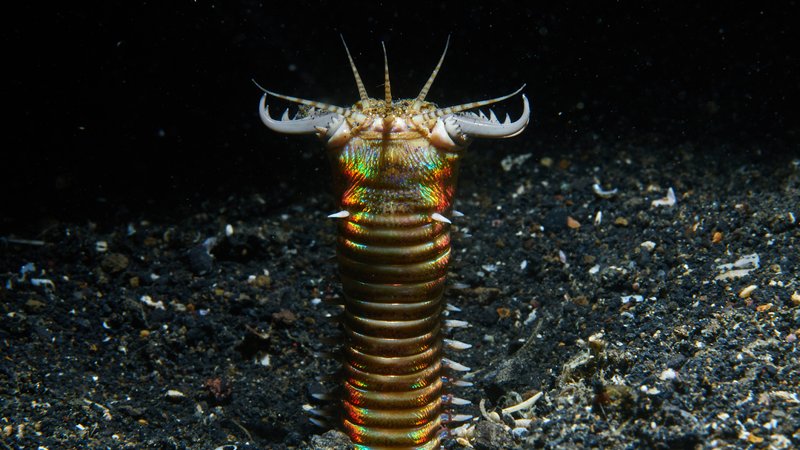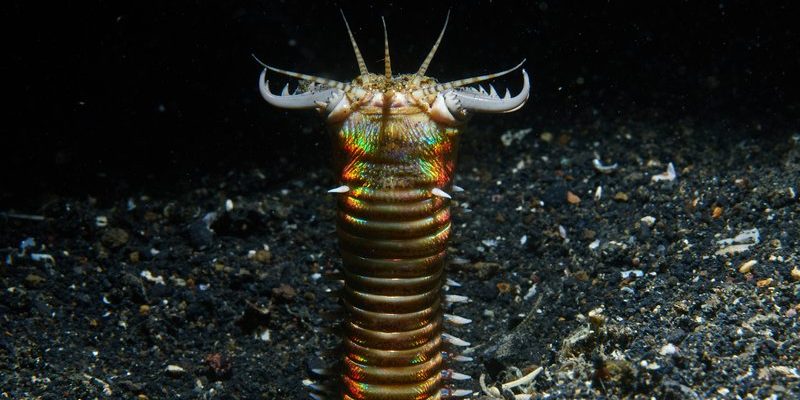
Bobbit worms, scientifically known as *Eunice aphroditois*, are long, segmented worms that can grow up to three feet in length. They’re found buried in sand and mud at the ocean’s bottom, typically in tropical and subtropical waters. But why should we care about them? Well, these worms are not just fascinating to look at; they’re also key players in maintaining the health of marine ecosystems. Let me break down how they fit into the bigger picture, along with their sandbed neighbors and the delicate balance of life below the waves.
What Are Bobbit Worms?
Bobbit worms are part of the polychaete family, which means they have many bristles along their bodies. You might be wondering about their name, which sounds like it belongs in a horror flick. Well, legend has it that they got their name from a gruesome story of a woman named Lorena Bobbitt. But let’s not dwell on that; instead, let’s focus on what makes these worms so unique.
Typically, Bobbit worms have a bright coloration that can be quite striking. Their long bodies can be green, pink, or brown, and they often have a series of feathery gills protruding from their segments. These gills not only add to their beauty but also help them breathe in their sandy homes. Picture them waving gracefully, almost like underwater flowers, as they settle into their sandy burrows.
Bobbit worms are often mistaken for sea serpents due to their length and movements. However, their most fascinating feature is their predatory nature. They use their powerful jaws to catch fish and any unsuspecting prey that swims too close to their hiding spot. Imagine being a fish, blissfully swimming through the water, when suddenly—bam! The Bobbit worm strikes.
The Role of Bobbit Worms in the Ecosystem
So, why do Bobbit worms matter in the marine ecosystem? Well, they’re predators, yes, but they also play a vital role as scavengers. Their existence helps to keep populations of smaller fish and other marine creatures in check. By doing this, they prevent overpopulation and ensure that the sandbed remains balanced.
Here’s the thing: every creature in an ecosystem serves a purpose. Bobbit worms, by feeding on various organisms, help recycle nutrients back into the ecosystem. Their feeding habits contribute to the overall health of the *benthic zone*, which is the lowest level of a body of water. Imagine a bustling marketplace where transactions happen, and goods are exchanged; that’s how these worms contribute to nutrient cycling on the ocean floor.
Additionally, Bobbit worms create a unique habitat for other marine life. Their burrows provide shelter and breeding grounds for various organisms, such as tiny fish and crustaceans. It’s like having a cozy apartment complex in the bustling city of the ocean floor, where many tenants can thrive.
Sandbed Ecosystem Dynamics
The sandbed ecosystem is a complex and dynamic environment. It consists of various organisms, from microscopic critters to larger fish, all interacting in a delicate balance. Bobbit worms are just one piece of this intricate puzzle. The sandbed also hosts organisms like sea cucumbers, crabs, and other polychaetes, all contributing to the health and stability of this environment.
What’s fascinating is how these organisms interact. For instance, when Bobbit worms hunt, they stir up the sand, allowing nutrients to rise to the surface. This process supports the growth of microorganisms, which in turn feeds other animals. It’s a perfect example of the saying “one thing leads to another.” The health of the sandbed ecosystem relies heavily on these interactions.
You might be surprised to learn that disturbances in this ecosystem, whether from human activities or natural disasters, can have a ripple effect. If Bobbit worm populations decline, it can lead to overpopulation of their prey, which can then cause a decline in the overall health of the sandbed. It’s a delicate balance, and each player, including our friend the Bobbit worm, plays a crucial role.
Threats to Bobbit Worms and Their Ecosystem
Like many marine creatures, Bobbit worms face several threats that could disrupt their delicate ecosystem. Pollution, habitat destruction, and climate change are just a few of the issues they encounter. Chemicals and waste entering the ocean can harm these worms, affecting their ability to survive and thrive.
Overfishing is another significant threat. As certain fish populations dwindle, the balance of the sandbed ecosystem could be disrupted. You might wonder what this means for Bobbit worms. Well, with fewer fish to eat, their populations could decline, leading to a chain reaction that impacts the entire ecosystem.
Additionally, the loss of coastal habitats due to rising sea levels puts more pressure on these worms. Their sandy homes are washed away, leaving them vulnerable. It’s a tough world out there for these unassuming predators.
How Bobbit Worms Contribute to Marine Health
Bobbit worms are like the unsung heroes of the marine world. By maintaining the balance of their ecosystem, they help ensure that everything from the smallest plankton to larger fish populations remains healthy. Their burrowing and feeding habits create a thriving habitat that supports countless marine organisms.
When Bobbit worms thrive, the entire sandbed ecosystem flourishes. Healthy worm populations mean better nutrient recycling, improved water quality, and a stable environment for other marine life. Imagine a flourishing garden, where each plant and flower supports the others; that’s how Bobbit worms contribute to the overall health of their underwater world.
Research has shown that maintaining biodiversity, including species like Bobbit worms, is crucial for the resilience of marine ecosystems. This means that protecting their environment is not just about saving the worms; it’s about preserving the intricate web of life that exists in our oceans.
Conservation Efforts for Bobbit Worms
Conservation efforts for Bobbit worms are more critical than ever. These efforts often include habitat restoration, pollution control, and raising awareness about the importance of marine ecosystems. Many organizations work tirelessly to protect coastal areas, ensuring that these precious habitats remain intact for future generations.
You might be wondering how you can contribute. One simple way is to support sustainable seafood practices. By choosing seafood that is caught responsibly, you help protect marine life, including Bobbit worms and their habitats. Additionally, spreading awareness about the importance of these creatures can go a long way in fostering a greater appreciation for marine ecosystems.
While Bobbit worms may not be as recognizable as dolphins or turtles, their role in the ocean is invaluable. Every small effort counts, and together, we can help ensure that these remarkable creatures—and the ecosystems they support—continue to thrive.
Final Thoughts on Bobbit Worms and Ecosystem Dynamics
Bobbit worms might seem like an odd topic, but understanding their role in the sandbed ecosystem helps us appreciate the complexity of marine life. Each creature, including the often-misunderstood Bobbit worm, contributes to the health of our oceans. By learning about them, we can better protect their habitats and support the intricate web of life in the sea.
Next time you think about the ocean, remember the Bobbit worm and the vital role it plays beneath the surface. It’s a reminder that even the smallest players can have a big impact. So, let’s do our part in keeping our oceans healthy and vibrant for all the amazing life they hold.

